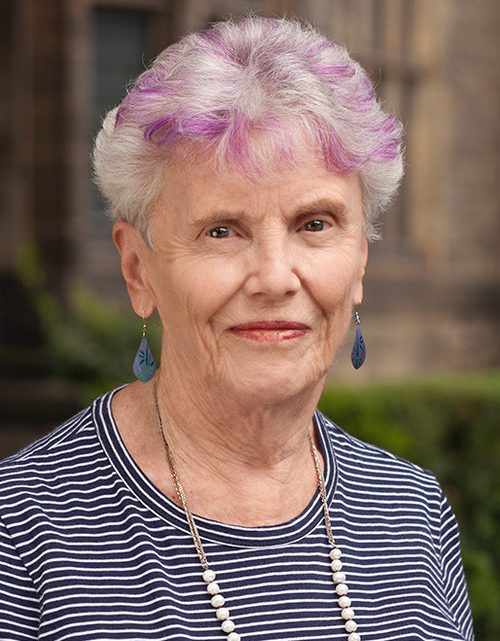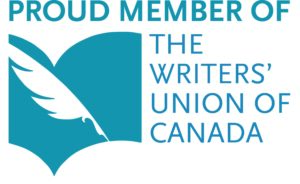
Interview with Mary Lou Dickinson
Mary Lou Dickinson has published four books, One Day it Happens, a collection of short stories, and three novels, Ile D’Or, Would I lie to You, and most recently The White Ribbon Man, a murder mystery set in downtown Toronto at a 171-year-old church hidden behind the Eaton Centre. Her short stories have appeared in numerous literary periodicals over the years as well as on CBC radio.
After graduating from McGill University in Montreal, Mary Lou moved to Michigan. Later she settled in Toronto where she still lives and writes.
Interview with Mary Lou Dickinson
You were a long-time member of the Toronto writers’ group, Moosemeat. Their website tells us they allow for no fees (and no poetry) but won’t reveal where they got their name. Will you? Or will this result in your washing up at Harbourfront wearing a pair of concrete shoes?
Yes, probably I would wash up on some beach. Or I would quickly be discredited as having given a false answer. There are many stories of how the group got its name circulated in the group, but no one seems to know any more which one is the correct version. I found it interesting that this urban group had adopted a name that seems to fit my northern background more than it fits any of us now living in the city. In hunting season during my youth, when the hunters arrived back in town, most had a huge moose tied to the roof of the car.
Your first paid publication was a poem at the age of seven that appeared in The Toronto Telegram where your grandmother had a column. What was the poem about? And how did your grandmother, a working women journalist in the 1940’s inspire you?
The poem was about snow, something that would be pretty natural for a child in the north where winter seemed to go on forever. I found the poem when I was downsizing to move a few years ago. It was so awful that I must have destroyed it. My grandmother must have been trying to encourage me..
Nan certainly inspired me by demonstrating that women did not have to remain invisible and anonymous. One of the delights of her life was going to Hollywood to interview the stars. I still have photos of her with people like Ronald Reagan (as a Hollywood actor), Joan Fontaine and Paul Newman. When she returned to Toronto with her collection of autographed photographs, she wrote about the food these stars liked as well as the restaurants they frequented. These stories delighted her readers and she received many letters saying so.
Oh, and by the way, my grandmother retired at the age of 75. It was then that she bought herself a little white sports car and took up a new career as a model!
Your first book was published at the age of 70, when you released One Day it Happens, a collection of short stories. That’s a bit of a gap from your Toronto Telegram gig at seven, but also the subject of your next book, a memoir of persistence. Can you tell us about it?
The memoir begins in the northern Quebec mining town, something that I have left in reality and become an urban denizen. In my imagination, I don’t seem to be able to leave this place, this cauldron that boils over at times into story. Nor do I want to. The overriding theme of the memoir is the journey to become a writer that took a lifetime. And persistence is certainly among other things that kept me going. The story also follows a young child who resisted oppression without recognizing what this was all about but provided the underpinnings for becoming a feminist and a social justice advocate in my life and in my writing.
The White Ribbon Man is your first crime novel. What inspired you to write something in this genre? Will you write another?
A fellow volunteer at the Distress Centre many years ago suggested that it would make an interesting mystery to find a body in the washroom of this particular downtown Toronto church. He was going to write it with me, but soon confessed he was too busy. My imagination demanded I write it anyway. I was curious as to how a spiritual community and the individuals in it would react in the aftermath of violence, especially as so many would be under suspicion for a variety of reasons.
I don’t know if I will write another mystery. People like the detective, Jack Cosser, and a series could be developed around him. I do have a couple of ideas. But at my age (81), I don’t know that I want to write another novel or mystery. So I have been writing short stories of late, working toward another collection. And a nonfiction book about retirement that I have challenged myself to finish in six months. As a writer, I have always followed my muse rather than tried to control it and at this point I don’t know where it wants to lead me.
You are a former parishioner of The Church of the Holy Trinity in Toronto where The White Ribbon Man takes place. How did they feel about you putting a dead woman in their toilet cubicle and setting up the Anglican Priest as a suspect? Perhaps this is why you are now “former.”
They gave me the honour of allowing me to present the book after a recent Sunday service. No one indicated any discomfort with having the book set in their church, and many purchased it. I gave them some idea of how I presented it elsewhere which honours the church, its inception and its continuing focus on social justice. Maybe I will receive more comment once some of them have read it.
The Anglican priest, an imaginary character, is one suspect among many! I am “former” for entirely unrelated reasons. Many years ago, I realized I could not do the church thing indefinitely, that I wanted to ride my bicycle on Sunday mornings. Or go to an art gallery and get lost in the Henry Moore gallery or some other exhibition. Go over on a ferry to the island and read a book under a tree! I was pleasantly surprised though when I presented THE WHITE RIBBON MAN after the recent service that I felt both welcome and comfortable. I might even go back from time to time. Or not!
You worked for decades at a helpline that counselled women suffering from abuse, belonged to a church famous for its social activism, and included in The White Ribbon characters and situations that speak to the plight of marginalized communities. Social justice appears to be a theme in both your life and your writing. What do you think is the most pressing social ill we are currently facing in Canada and what could some of us be doing about it?
Oh my! I have never put myself forward into the spotlight as a commentator on political issues. But it is hard to resist mentioning the way some of our present “leaders” are denying climate change. And that they are doing away with policies that were put in place to try to ameliorate the damage we as humans have done to the environment and the planet. This seems to me to be the most pressing issue since if we don’t solve it we can’t deal with anything else. Dealing with it with honesty and vigour would require those who seem more concerned with the wealth of the few and increasing that to alter their focus to come up with ways and means to change what we have wrought upon this planet. Also pressing is the lack of respect by many for the democratic process that places us in jeopardy in many areas. It seems that many politicians who are elected to be our representatives and serve the people don’t care about what we think and are willing to push legislation into law without hearing the people despite our concerns and opposition. And as a woman who has worked in the area of violence against women, I am concerned that many politicians who now hold power have little respect for women and are taking actions that move the causes we have worked for backwards. It seems women have once again become a “special interest” group and a threat to the established male social hierarchy. As have other marginalized groups: people of colour, those who live in poverty become even more ignored or stereotyped. None of these people are given the respect they deserve simply as people.
What action can you/we take?
Probably write about it and get out and support politicians who base their activism on ethical and moral principles. Express your views and support progressive candidates and causes.
A recent review of The White Ribbon Man describes your writing as “closer to an old school Dashiell Hammett potboiler, minus the hardboiled detective and foreboding mood.” Your detective is a bit different than the usual tough guy. Can you tell us a little bit about him and what inspired his chamomile tea sipping character?
No particular person inspired the character, Jack Cosser, who is the lead detective in the investigation. I was interested in a character within the police force who was an activist for change both within that bureaucracy and within society. He had to have the skills and desire to be a police officer, but also the sensitivity to begin to understand both personal and social justice issues and the diplomacy and toughness to work within a system that lacked in many ways in social awareness and compassion and showed the flaws of a large bureaucracy.
What book did you read and love but are ashamed to admit it? No fair mentioning shades of anything. This has been done. We want to know your unique guilty pleasure.
I don’t think I have a guilty pleasure to confess around any book that I would not admit to having read. There is one TV series I often watch that I rarely tell anyone about. So many people look down on those who get some pleasure from Coronation Street. I did also until I myself became somewhat of an addict. Such a contradiction for someone who enjoys the classics and good contemporary literature. How can I have become addicted to a bevy of characters who are often quite silly or over the top. Imagine! What would my grandmother think? Come to think of it, she would probably want to watch with me. Dad, on the other hand, would likely have been horrified! Perhaps my mother would have been also.
Find out more about Mary Lou and her books at http://www.maryloudickinson.com/
Carole Kennedy is an Edgar nominated thriller and crime writer who publishes under her Irish name, C.S. O'Cinneide (oh-kin-ay-da). Her novels include the Camino thriller, Petra's Ghost, and the Candace Starr crime series.



